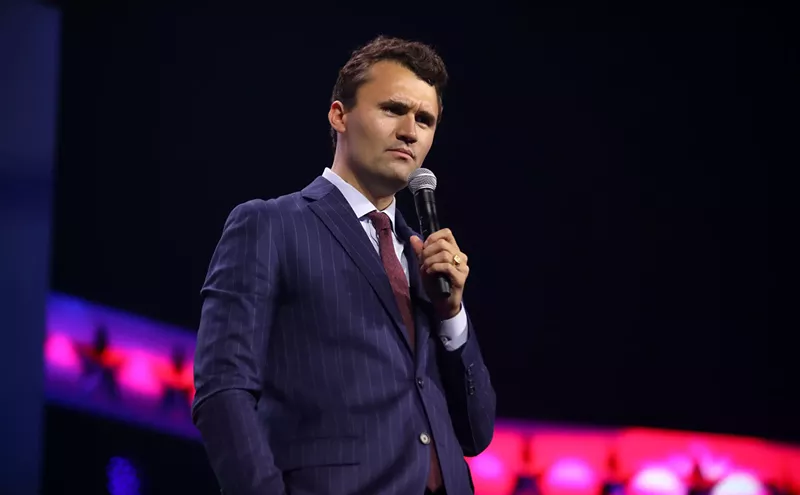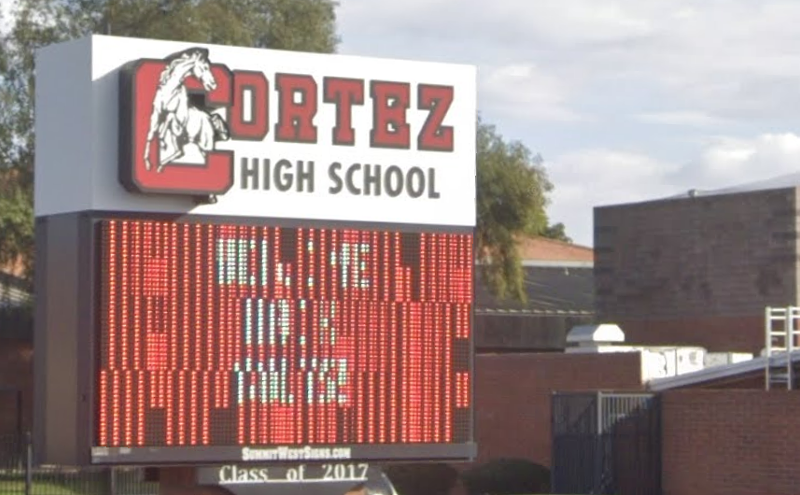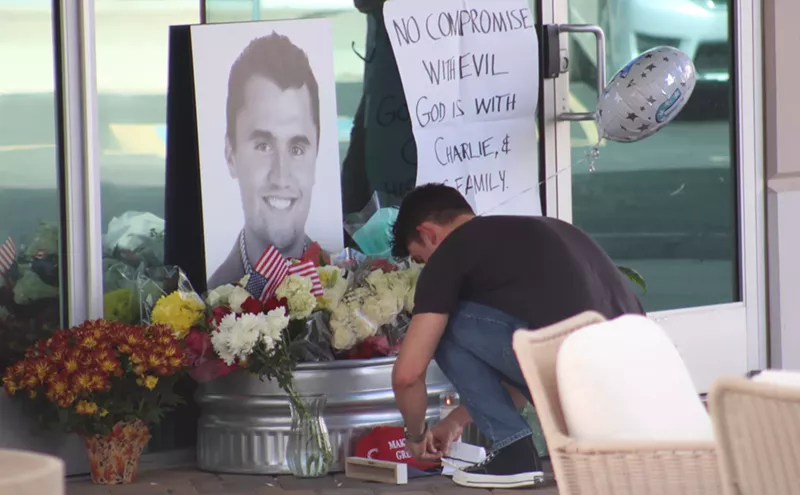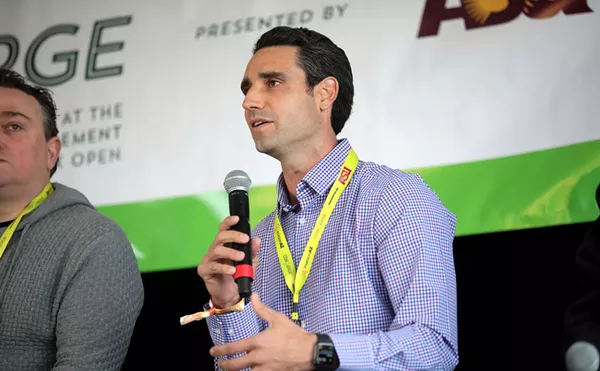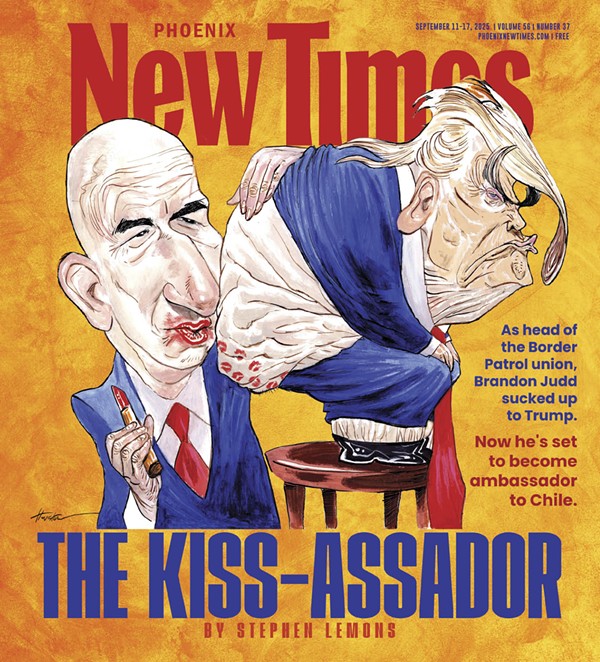On a sunny Saturday morning in April, more than two dozen men, women, and children march up Central Avenue, on the final stretch of the Pride parade. The pro-gay march has taken place in Phoenix every year since 1981, but it's the first time this particular group has joined the thousands of people celebrating. A Lady Gaga hit blasts from the speakers of a nearby multicolored VW bus, but this is not really a Lady Gaga kind of group. These people stand out mostly because of their outfits: The men wear slacks, shirts, and ties, and the women wear dresses.
In fact, they look as if they are on their way to church, and that would not be a bad guess. The crowd along the parade route gasps then hollers, reading the group's banner: "Mormons Building Bridges." Other signs declare that "God loves all His children" and "Mormons heart LGBT."
The members, friends and family of ALL Arizona -- a local support group for gay members of the Church of Jesus Christ of Latter-day Saints -- reach the end of the parade route at Steele Indian School Park. It's there that they encounter another religious group.
Holding banners that condemn homosexuality and surrounded by a fence that separates them from festival-goers, the protesters hurl insults. ALL Arizona members Jon Abhau and his mother, Meg, are the first to notice the picketers. They approach them, and Jon, a tall, blond 14-year-old in a rainbow-colored bow tie, tries to hand one of the protesters a sign that reads "'Love one another' -- Jesus." The protester won't even look at the boy. The sign lands on the ground next to the protester's shoes.
As his mother looks on proudly, Jon Abhau simply smiles and walks away.
Founded in 1830 by Joseph Smith, the Church of Jesus Christ of Latter-day Saints began in upstate New York with only six members. Today, according to official church numbers, there are more than 15 million members worldwide.
The church's history begins with Smith, who, with the help of a seer stone, translated the "Book of Mormon" (which would become the church's primary scriptural text) from a language he called "reformed Egyptian." Klaus Hansen, professor emeritus in the history department at Queen's University in Ontario, explains in his 1981 book Mormonism and the American Experience that Smith would stick his head into a hat that contained his seer stone, and in the darkness he would see spiritual light and, within it, writing.
In its initial years, the church moved from New York to Ohio and then to Missouri, where members were expelled by settlers. By the end of the 1830s, Mormons had moved to Illinois. It was there that Smith and his brothers were murdered and Brigham Young took over leadership of the church. It was Young who led church members to what is now Utah. The Mormon Corridor (which includes some parts of California, Idaho, and Arizona) had been established.
So how did a six-member church become such a well-established religious institution? There's strength in numbers. William J. Whalen, an expert on comparative religion, suggests in his 1964 text The Latter-day Saints in the Modern World that the church's proselytizing program (done through worldwide missions that young Mormons complete) has been picking up speed since the early days of the church and will continue to do so.
But what about someone who wants to belong to the church but happens to be gay? Traditionally, this has presented a challenge (to put it mildly), but recently, Mormons have made efforts to keep homosexuals in the flock.
In 2012, the church reached out to members who identify as "same-sex attracted" (the church's preferred term) by publishing Love One Another: A Discussion on Same Sex Attraction on a website it created, www.mormonsandgays.org. The church has changed its official stance regarding homosexuality. According to the text, attraction to a person of the same gender is not a sin, but acting on it is. Furthermore, the stance reads, people don't choose to be gay, but they choose how to respond to it. If a church member is gay but doesn't act on it, then she or he still can have full fellowship.
So you can be gay and Mormon, as long as you don't act on the former.
The Phoenix-area Church of Jesus Christ of Latter-day Saints declined to comment on ALL Arizona and referred to the church's official website when asked about its official stance on homosexuality, so it's hard to know what's the thinking on this.
The somewhat softer stance could be a way of making up for bad PR, along with an attempt to keep up membership numbers. In 2008, the church publicly announced its support for California's Proposition 8 (a state constitutional amendment that defined marriage as between a man and a woman) and encouraged members to make financial donations. Members ended up donating more than $20 million.
By 2012, when the Supreme Court heard oral arguments on Proposition 8, the church had abandoned its crusade against same-sex marriage after negative press, and after seeing members walk away from the church.
Of course, it hasn't always been this way. The LDS church has a long history of supporting so-called reparative therapy, which included the use of electro-shock aversion therapy. In fact, it is well documented that in the 1970s, Max Ford McBride, a then-graduate student at Brigham Young University, a private university in Provo, Utah, owned and operated by the Mormon Church, carried out a study to explore the effects of painful shocks designed to get rid of homosexuality.
McBride gathered a group of BYU students as volunteers and administered shocks to their genitalia to try to cure them from the sin of homosexuality.
Today, gay LDS members who don't necessarily want to leave the church still struggle to find a place in two seemingly exclusive worlds. It's not for lack of trying. Affirmation: Gay & Lesbian Mormons, the first support organization for queer LDS members, known for its vocal opposition of some of the church's policies, was founded in 1977. By 2012, many other groups had formed, including Mormons Building Bridges, a Utah-based national grassroots organization with more than 5,000 members that focuses on stopping the alarming rate of homeless youth and teen suicide in Utah, as well as making sure gay Mormons feel loved and welcomed.
ALL Arizona was founded shortly after, and its members often work closely with Mormons Building Bridges.
In 2012, almost five years after graduating from BYU with a degree in biophysics, a young man named Bryan Hendrickson met with Bryce and Sara Cook, fellow Mormons, and told them his idea of creating a support group for Latter-day Saints members who identify as queer. The Cooks, who have two gay sons and live in Mesa, agreed and ALL Arizona was born.
Bryce, a legal consultant, and Sara, a substitute teacher, knew of Hendrickson through their son Trevor (who had come out to them a few years earlier). Trevor, 28, works for the U.S. State Department and lives in China.
Two years after its conception, the group is working to bridge the gap for its participants between being an active member of the church and coming out. Meetings are held monthly at a member's home and provide a safe space for LGBT Mormons who want to share their stories. Hendrickson, who lives in Phoenix and is a student University of Arizona's College of Medicine, says the group's goal is to ensure that no one feels alone because of their sexuality, but most of all, to try to make the church a welcoming place.
According to the Encyclopedia of Mormonism, viewed as a semi-official church source, Latter-day Saints view sin as a "willful breaking of covenants with God" that ruptures relationships, families, and creates social disorder. To escape sin, Mormons must repent, a process that requires suffering and forsaking the sin.
In Mormon theology, having same-sex attraction and thoughts is not a sin, but acting on them certainly is.
Growing up Mormon and being queer certainly can be a challenge. Although coming out no longer equates to automatic excommunication (the process of taking away someone's membership in the church), the fear of being ousted still is very much present.
Kate Kelly learned that the hard way. Kelly is founder and a board member of Ordain Women, an LDS feminist organization that calls for the ordination of women. It was founded in March 2013 with the launch of a website that contained 19 profiles and testimonials of people supporting female ordination. By May 2014, there were more than 400 profiles on the website. On June 23, Kelly received an e-mail from Bishop Mark Harrison explaining she had been excommunicated. Kelly has said she likely will appeal the decision.
The similarities between the pro-feminist and pro-gay movements within the church have not gone unnoticed. Neither effort has been easy.
The first meeting of ALL Arizona, held in May 2012 at the Cooks' home, attracted barely a dozen people, Hendrickson says. Now, they welcome new members each month and have held two annual conferences with more than 150 people each.
"All we really want is for the church to be a more welcoming place for LGBT members," Hendrickson says. "We really want people to not go through any of this alone and we just want them to have an opportunity to talk to people who will love them and accept them."
Gay Mormons certainly are not the only religious people who face challenges when coming out. In fact, most of the world's organized religious movements have historically viewed homosexuality as a sin. For many of these religions, the basis can be found in the Bible, considered to be sacred scripture, specifically in Leviticus 18:22 ("Do not have sexual relations with a man as one does with a woman; that is detestable") and 20:13 ("If a man has sexual relations with a man as one does with a woman, both of them have done what is detestable. They are to be put to death; their blood will be on their own heads.")
According to a 2002 collection of essays, Homosexuality and World Religions, penned by various religion experts, the main argument that Roman Catholic authorities used against homosexuality is that sex should be used for procreation.
Dignity USA is a national organization based in Boston that works for the equality of U.S. Catholics who identify as LGBT. Marianne Duddy-Burke, the organization's executive director, explains that the official teaching of the church is that being gay is an intrinsic disorder and an inclination to evil.
"That's what we're up against," she says.
And yet, the numbers continue to grow, Duddy-Burke says. In fact, according to a 2012 Pew Research survey, 54 percent of U.S. Catholics support same-sex marriage. In 2001, it was only 40 percent.
"Very few people believe homosexuality is a sin anymore," Duddy-Burke says. "The most important people in the church are the parishioners. That's where the change is going to come from."
It can get even messier when it comes to other religions. Islam, for example, leaves no loophole for gay Muslims since its holy scripture, the Quran, is explicit in its disapproval of homosexuality.
Depending on your branch of Judaism, things might not be much better. The Orthodox Jewish Movement expressly prohibits same-sex marriage.
The Church of Jesus Christ of Latter-day Saints has seen a considerable shift in its views of homosexuality -- but the church still does not condone it. It's more a matter of accepting the person but not the "sin." From 1830 until very recently, homosexuality was seen as unnatural, abhorrent, and most significantly, as a choice.
David Knowlton, a professor of anthropology at Utah Valley University who specializes in the anthropology of Mormonism, says the shift in the church's stance is significant but still represents big hurdles for gay LDS members.
"Repression and denial has moved toward openness to where nowadays one can recognize and can actually claim an openly gay identity," he says, "but one can't claim to be in an active partnership."
As with most matters in the Mormon Church, a lot has to do with local leadership, so if you have liberal local leaders, it is possible to be actively gay and still get assignments to serve the church -- but it is far from frequent. In fact, Hendrickson and other ALL Arizona members who have chosen to be actively LGBT say they no longer have callings, despite still being welcome to attend worship,
Knowlton says that although the church still has a long way to go in terms of LGBT equality, organizations such as ALL Arizona are not likely to be in danger of excommunication.
Kate Kelly's excommunication could have a chilling effect on the gay Mormon community, Knowlton says. The church is trying to say two things with the excommunication: That it's a matter of local leadership and that the issue is the activism because people should put themselves in the hands of the Lord, follow the leadership of the brethren, and should never try to change the church.
"The current leadership is far too adept at fighting gay marriage and also feminism. A shift would require real strong reworking of the LDS theology."
Knowlton is referring to The Family: A Proclamation to the World, issued by the church in the mid-1990s. The document defines the official position of the church on issues such as marriage, sexuality, and family. The first lines of the document state, "We the First Presidency, and the Council of the Twelve Apostles of the Church of Jesus Christ of Latter-day Saints, solemnly proclaim that marriage between a man and a woman is ordained of God and that the family is central to the Creator's plan for the eternal destiny of His children."
However, Knowlton says, a difference between Kelly's case and other kinds of activism (such as the fight for LGBT rights) is that groups like ALL Arizona are building support and fellowship -- not fighting the church. This is vitally important for a church so concerned with membership numbers, whose proselytizing efforts are never-ending.
Lisa Davis is a journalist (and former New Times staff writer) who wrote a book, The Sins of Brother Curtis, in which she recounts the true story of a young man molested by his Mormon Sunday School teacher and the epic legal battle the church waged to defend itself on grounds of religious freedom. She explains that Mormon theology includes the idea that behavior can be controlled and, therefore, changed, which means that (because Mormons view homosexuality as a behavior) it is possible to decide not to act gay.
"The church is saying, 'We're compassionate in a humanitarian sense, but we don't embrace the gay lifestyle,'" she says.
Historically, she explains, Mormon communities have shunned members for their behavior. However, in contrast to other religions, it is possible for Mormons who have been excommunicated to be rebaptized through repentance, which takes at least a year.
Although, and as a consequence of the church's current stance, being gay does not necessarily equate to excommunication, experts interviewed for this story agree that queer Latter-day Saints still risk being treated as less than other church members because of their sexuality.
As a student at BYU, Bryan Hendrickson found himself surrounded by heterosexual couples on a fast track to marriage and family. Tall with glasses and auburn hair, Hendrickson sits at a cafe in downtown Phoenix on a Saturday morning in late March, scratching his goatee and recalling his college days. He says he felt like an outsider, until he finally realized there was a reason why he didn't want that for himself.
But it took him almost 10 years to come out.
"I thought for a long time that being gay was this evil, terrible abomination. I was afraid of people finding out," he says. "I think that's been the biggest challenge: dealing with that personally and coming to terms with it."
Hendrickson has been out since summer 2011. Now 33, he recalls that he was really nervous about sharing the news with his parents. But though it was hard at first, he says, his family has made an effort to make him feel welcome and even agreed to meet his boyfriend for Christmas.
Before Hendrickson told his friends and family he was gay, he was a typical devout Mormon: He attended three hours of church every Sunday, served in different callings, and went to social activities at least once per week that often focused on service. He admits most of his social and family life was tied to the church.
Once he understood his sexuality and decided he wanted to search for a partner in life, Hendrickson assumed there were no answers for him in the church and walked away from his ward.
ALL Arizona, he explains, does not tell its members whether they should leave or stay in the church, but rather provides a space where each can arrive at his or her own conclusions.
"I want people to be less afraid of who they are and find people who are able to accept them and love them," he says.
Hendrickson says he agrees. After announcing to friends and family he was gay, he thought he had to leave the church and stopped attending. Shortly after, he felt his life was missing something.
Still, he says, attending worship can be painful, so for now, he's holding out on making decisions about his future in the church.
"It had only been like six months or something when I started going back to the ward, and that's when I met the Cooks," he says. "Now we've formed this group of people who are welcoming and supporting and it has at least created the possibility of staying in both worlds and saying 'I'm Mormon and I'm gay.'"
Bryce and Sara Cook have a big house in Mesa. In the living room, a huge wooden letter C -- for Cook -- hangs on the wall. Dozens of family photos surround it, and to the side is a plaque bearing a quote from Mormon Elder David A. Bednar: "The tender mercies of the Lord are real. They do not occur randomly or by coincidence."
A photo of the family hangs in the foyer, proudly displaying Bryce and Sara and all six Cook kids, wearing their best attires and smiling at the camera. They're the all-American Mormon family.
The Cooks met at BYU in 1983 and married a year later. Two of their six kids are openly gay. Their oldest son, Trevor, came out to them a few years ago through a handwritten letter they received before Christmas.
"A big thing that hit me was that I had never been very kind in my speaking about gay people," Bryce says. The next thing that hit him: "This was not a choice."
Trevor made the announcement while he was a student at BYU. After graduation, he started an internship in China. In 2011, the Cooks visited Trevor in China. During a hike, their son explained that his sexuality would not change or go away.
For the Cooks, it was hard to imagine a life plan different from their own.
"You graduate from high school, you go to college, go on a mission, get a good job, get married, and have a family," Bryce says. "We lived that dream and we wanted the same thing for our kids, and all of the sudden this happened."
Trevor came out publicly in 2012. After, the Cooks learned that Tanner, another of their sons, was also gay.
Bryce started doing a lot of research on what it's like to be a young person who identifies as LGBT in general, and LDS in particular. He describes the experiences as "cathartic."
Trevor was interested in forming a group for gay Mormons in Arizona, but before he could do so, he was hired by the U.S. State Department and went to live in China. He had messaged Bryan Hendrickson and began planning, so when Trevor left, the Cooks took over.
"The first objective was outreach to gay Mormons and show them they are part of the church and love them and support them," Bryce says. "The second objective was education to straight members."
Sara says that she hopes the church will see further change in its stance. She wants to see her sons gain full fellowship in the church as well as to be happy and have their own families. This year marked the first time the Cooks attended (and marched) during Phoenix Pride.
Jonathan Manwaring and his wife, Rachel, also host ALL Arizona meetings. Manwaring's brother, who lives in New York, is an openly gay active Mormon who still regularly attends church.
Manwaring, a physician in a community health center in Phoenix, was born and raised in Idaho and says his and his brother's upbringing was traditional, conservative, and faith-based. He and Rachel moved to Arizona 11 years ago and have raised their five children here.
Jamison, Manwaring's youngest brother, came out to him and Rachel a decade ago. Manwaring says that after the initial shock, there were many difficult times and it has taken him and the rest of his family a while to learn about something they knew virtually nothing about.
The couple heard about ALL Arizona more than a year ago through social media, when the group was publicizing its first annual conference. The Manwarings attended and found themselves moved by what Jonathan calls a spirit of love, unity, understanding, and togetherness. After, they volunteered their home for meetings.
"The best part of ALL . . . is being able to be honest, authentic, and supporting among people who share common beliefs and faith traditions," Manwaring says. "It allows us to support and love one another in the spirit of true Christian love."
Manwaring says that, as an ally, he hopes that LGBT Mormons can find themselves in these two worlds and feel welcome in both.
"My hope is that as a church we can be so welcoming and loving toward our LGBT members that they'll want to stay active and a part of our faith," he says. "I want all of my gay brothers and sisters to know that our doors are open to you and we want you to worship with us."
Emily Clyde Curtis and her husband, Nate, also offer their home for the monthly support group meetings. Curtis, who edits a Mormon feminist magazine called Exponent II and holds a master's degree in theology from Harvard, has three kids and serves along her husband as a Cub Scout master with the Boy Scouts of America as part of their callings.
In December 2011, Curtis set out to devote an issue of her magazine to LGBT Mormons and says that after reading the essays that some gay church members submitted, she knew she had to be a vocal ally.
Curtis had voted against Proposition 102, an amendment to the state constitution that defines marriage as between a man and a woman, in 2008 but had never been vocal about her support for the LGBT community.
After the publication of the issue on gay Mormons, Curtis decided to look for a local organization to join. She found ALL Arizona.
Curtis says she thinks LGBT Mormons are asked to make an impossible choice of remaining celibate and enjoying full participation in the church or finding a loving relationship and risk being marginalized from the church and even their families.
She thinks ALL Arizona can help change this.
"My favorite group meetings are when we go around and do introductions," Curtis says. "This group is so loving and respectful that it isn't uncommon to have one person tell their story of pain, hurt and anger about how their family and the church treated them when they came out."
In March 2013, Meg Abhau and her 13-year-old son, Jon, played a game of Hangman. It was Jon's turn. The phrase Meg had to guess: "I am like Andy."
Andy is a family friend who happens to be gay.
Meg rushed to Jon, gave him a hug and assured him he was loved. Then she began to make plans to leave the Mormon Church.
"I just thought, if you were gay, then you left the church because you didn't fit in anymore," she says. "At first I was devastated and I was shocked, but instantly I started going into protection mode because I didn't want him to think there was anything wrong with him."
Jon told his mother he didn't want to be in the closet because it was a place of loneliness. He asked her if she could facilitate a public coming out. That night, Meg stayed up reading, and by the morning, she felt like a new person.
"We went on Facebook to let our friends and family know about Jon," she says. "It just got shared like 500 times and our blog went crazy. It got the attention of some uppers in church. We had several meetings with some of the heads in the church. "
Although the Abhaus still consider themselves members of the church, they don't attend regularly because the messages aren't meant for Jon, Meg says, adding that she quickly became worried that the church was ostracizing a portion of its people.
Meg has been trying to meet with high leaders of the church to make them aware of high suicide rates among boys who belong to the church; she believes this might be because some are gay and feel shame. Meg says that although no policy changes have been made, the church leadership is making an effort to understand and welcome gay members.
Last year, her family attended Pride in Washington, D.C. When church leaders found out, Jake was disciplined.
The Abhau family moved to Arizona from North Carolina in August. Since the move, the family has not gone to church. But they do attend ALL Arizona meetings -- one of the reasons they relocated to Phoenix. Meg says it's been the perfect solution.
Jon, who is in eighth grade at Highland Junior High School in Gilbert, says he first started questioning his sexuality after seeing two men together. After that, he went to Andy, the one gay person he knew, and started asking questions about how the church felt about gay people.
"I guess I was nervous about telling my parents, but I anticipated them being okay," he says.
"I actually didn't tell my dad. I had my mom do it. But he handled it really well." Jon says not attending church no longer feels strange, as he sometimes forgets what it was like to go at all.



